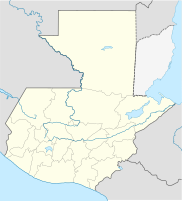Senahú
| Senahú | ||
|---|---|---|
|
Coordinates: 15 ° 25 ′ N , 89 ° 49 ′ W Senahú on the map of Guatemala
|
||
| Basic data | ||
| Country | Guatemala | |
| Department | Alta Verapaz | |
| City foundation | July 27, 1869 | |
| Residents | 54,471 (2002) | |
| - in the metropolitan area | 4,399 | |
| Detailed data | ||
| surface | 336 km 2 | |
| Population density | 162 people / km 2 | |
| height | 970 m | |
| Post Code | 16008 | |
| Time zone | UTC −6 | |
| City patron | San Antonio de Padua (Festival: June 8th to 13th) | |
Senahú (also San Antonio Senahú ) is a place in Guatemala and the administrative seat of the large municipality of the same name ( Municipio ) in the Alta Verapaz department . Around 62,000 people live in the 336 km² municipality and around 5,000 in Senahú.
geography
Senahú is located in the southeast of Alta Verapaz at an altitude of around 1,000 m. The municipality extends between the northeastern foothills of the Sierra de Xucaneb (Montañas Piedras Blancas) and the valley of the Río Cahabón in the extreme north and east. In the south, the mountain range delimits the municipality to the deep valley of the Río Polochic , which is already tropical. In Senahú the climate is temperate.
The municipality borders on the municipality of San Pedro Carchá to the northwest , Lanquín and Santa María Cahabón to the north, Panzós to the east and southeast , Santa Catalina La Tinta to the south, Tucurú to the southwest and San Juan Chamelco to the west .
population
Most of the population belongs to the Maya ethnic group Kekchí , the rest are Ladinos . Numerous residents are descended from German immigrants, which is reflected in the many German family names. In addition to the main town Senahú, the municipality also includes 63 hamlets and around 120 other rural settlements.
history
The place was created in the middle of the 19th century when Kekchí moved in. At first it was called Sechimail, then Nahuc, and finally it was called San Antonio Senahú. Until the municipality was founded on July 27, 1869, Senahú belonged to Salamá , today's capital of Baja Verapaz . From 1870 onwards, a large number of immigrants from Germany came to Senahú, who were given large estates there in the course of expropriations and mainly cultivated coffee , most of which was exported to Germany. The agricultural products were brought to the neighboring Panzós on the Polochic, embarked there and brought to Europe via the river, Lake Izabal , the Río Dulce and the Atlantic.
Economy and Transport
The traffic route through Lake Izabal and along the Río Polochic was once one of the most important trade routes in Guatemala. So Senahú was cheap for a long time. This changed, however, with the construction of the CA 9 Atlantic Highway, which runs from Guatemala City a little further south through the Río Motagua valley to Puerto Barrios . Senahú is now off the main traffic routes. At El Rancho, the well-developed CA 14 branches off the Atlantic trunk road CA 9 to the north in the direction of Alta Verapaz. In its southernmost Municipio Tactic , near San Julian, the winding and partly unpaved national road 7 leads east through the Polochic Valley to Izabal . Shortly before Telemán (Panzós), a branch line branches off to the north into the mountains of Senahú. This way it is around 280 km to Guatemala City and almost 140 km to Cobán, the capital of Alta Verpaz. The most important industry in Senahú continues to be agriculture, especially the cultivation of coffee and cardamom . Crafts are also important, and to a lesser extent tourism, despite the very attractive landscape.
Web links
- Senahú-Portalensenahu.com (span.)
- Tourist information (span.)
- Diploma thesis Uni San Carlos (PDF; 1.2 MB)
